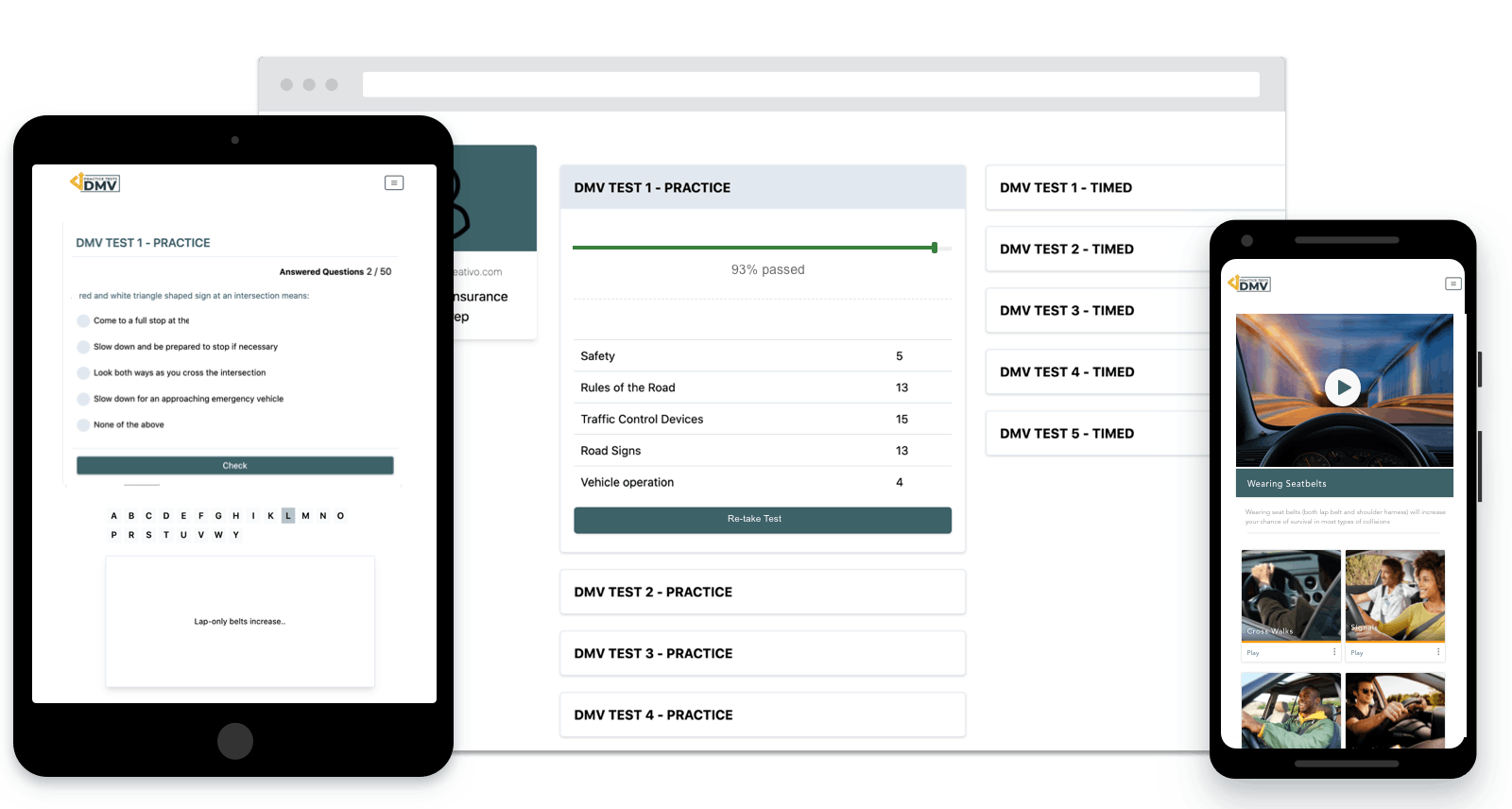Connecticut Learner's Permit DMV Test Prep
Connecticut Learner's Permit DMV Practice Tests - 2024
Pass the Connecticut Learner's Permit test with confidence! Our Connecticut Learner's License DMV practice test questions & detailed answer explanations are up to date with latest 2024 rules and regulations. Our driver's ed program has helped thousands of test-takers pass their Connecticut Learner's Permit DMV test and comes with a 100% Pass Money-Back Guarantee!
Get 750+ Connecticut Learner's Permit practice test questions that are similar to the ones you will find on the actual Connecticut Learner's Permit test. Our tests include road signs, rules of the road, traffic control devices, safety, vehicle operation and general driving knowledge. You also get access to our online vocabulary flashcards, driver's ed videos, and instant access to your Connecticut Learner's Permit DMV manual!
Our DMV Driving Test Prep Includes:
- 750+ DMV Test Questions & Answers
- On-The-Road Driver's Ed Videos
- Take Unlimited DMV Tests For 1 Year
- Practice Mode & Timed Exam Mode
- DMV Vocab Flashcards & Glossary
- Your State DMV Driving Manual
- Rules & Regulations Updated 2024
- Support From DMV Liability Attorney

CONNECTICUT DMV FREE TRIAL TEST

Gain instant access to 750+ DMV driver's test practice question (updated 2024) that are similar to the ones you will find on the actual DMV test.

Driver's License Test Study Vocabulary Flashcards & Keyword Glossary. You must know your vocabulary terms to pass. This is very important!

"Being able to take the DMV tests on my computer or phone was a big help. I used any free time I had to study. I felt totally prepared taking that test..."

Customer Support Services With a Department of Motor Vehiciles Attorney - If you have any questions at all please contact us.
Pass The Connecticut Learner's Permit Test!
Our Connecticut Learner's Permit test prep has helped thousands of test takers to pass their Connecticut Learner's Permit test.
Our Connecticut Learner's Permit exam prep comes with hundreds of Learner's Permit test questions that apply to Connecticut. Gain instant access to vocabulary flashcards, and Connecticut Learner's Permit ed videos.
Our Connecticut Learner's Permit test prep program has helped thousands of test takers pass their exam, and comes with a 100% Pass Money-Back Guarantee!

Already a member?
Pass The Driver's License Test Guaranteed
CONNECTICUT LEARNER'S PERMIT
FREQUENTLY ASKED QUESTIONS (FAQ’s)
You are eligible to get an Instruction Permit when you are 16 years old in Connecticut. Parental consent required if driver is under 18 years old
You are eligible to get your Intermediate Driver’s License when you are 16 and over if you:
- Complete Commercial or Secondary School or a Homeschool Driver Training Education with 40 hours of driving practice
- Hold Learner’s Permit for 120 days (commercial or secondary school) or 180 days (if homeschooled)
- Pass Vision Test
- Pass Road Test
When applying for a Learner’s Permit or Driver’s License in Connecticut for the first time, you must bring:
- Learner's Permit Application
- Proof of Social Security Number
- 2 Proofs of Residency
- 2 Proofs of ID
- Parental Consent Form (if under 18)
The Connecticut DMV office phone number is (860) 263-5700
The Connecticut DMV website is https://portal.ct.gov/DMV
All Connecticut office locations can be found here:
https://portal.ct.gov/DMV/Offices/Offices/Directions-and-Office-Hours
A parent or legal guardian should bring you if you are under 18 years old. If they are unable to, you must bring a completed Certificate of Parental Consent. The form can be found here: https://portal.ct.gov/-/media/DMV/20/29/2dpdf.pdf
old, your parent has to sign an Affidavit of Liability and Guardianship. While it is usually done at the DMV, there may be other options available if that is not possible. Contact the Connecticut DMV office at (303) 205-5600 for other options
A vision test is required to obtain a Connecticut Learner’s Permit and Driver’s License
A physical is not required to obtain a Connecticut Driver’s License
A photograph will be taken at the Connecticut DMV office after you pass your written test
- If you are at least 18 years old, you must hold their learner’s permit for at least 90 days and complete an 8-hour Safe Driving Practices Course at a private or secondary driving school
- If you are under 18, you should get 30 hours of classroom training with either a private driving school or a secondary driver’s education course and hold a learner’s permit for at least 120 days or choose the home training option, which requires 22 hours of classroom-like training and completion of an 8-hour Safe Driving Practices Course, but you must hold your permit for 180 days if you choose to train at home. An additional 40 hours of behind-the-wheel training is also required if you are under 18
